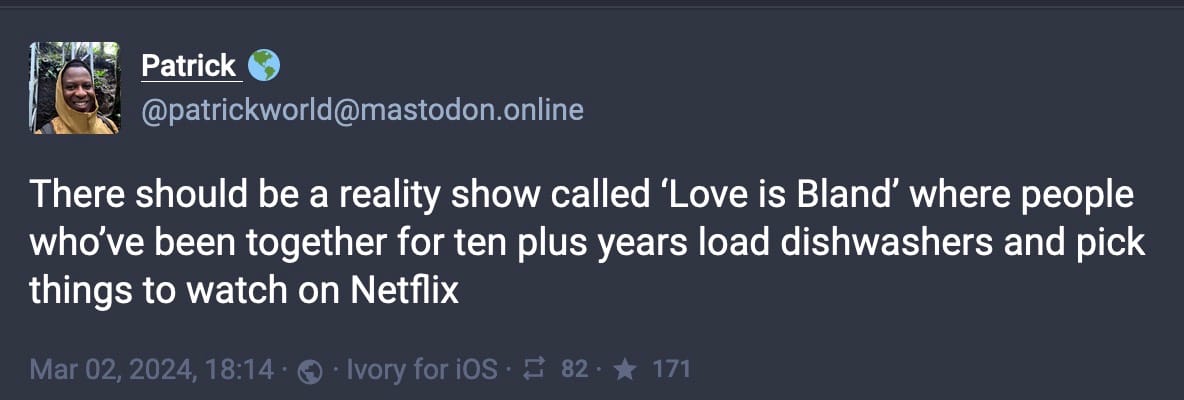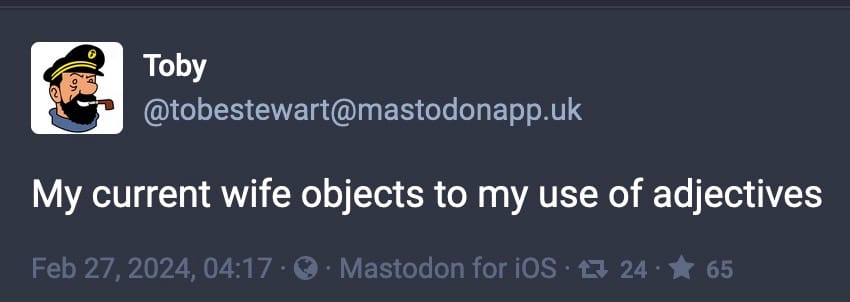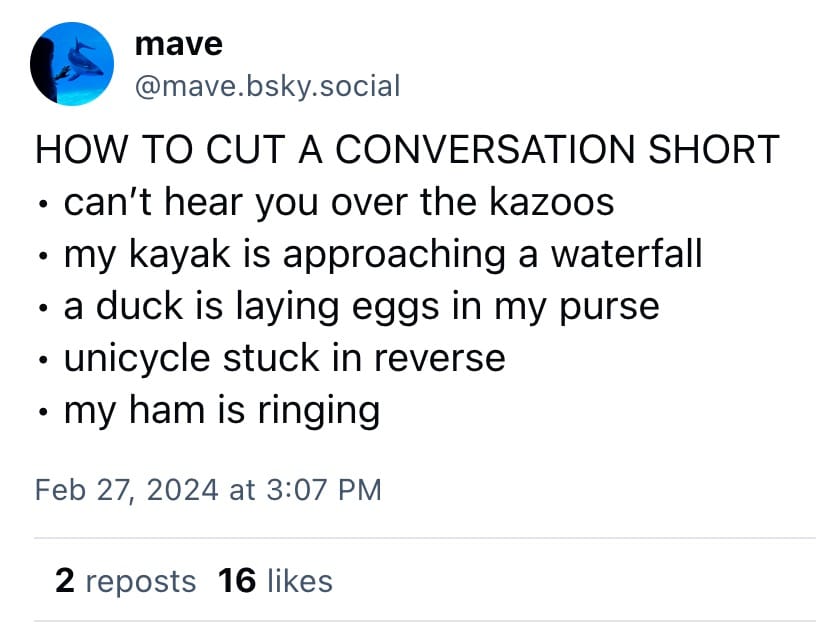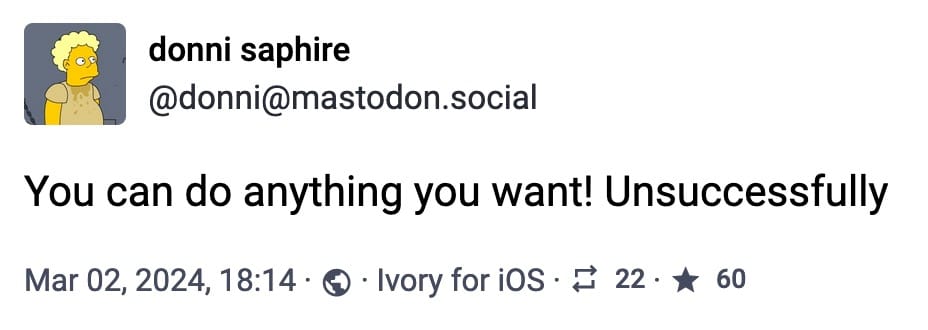Updates from Adam Isacson (March 4, 2024)
Hi, this is Adam. If you're receiving this message, it means you signed up on my website to receive regular updates. If you'd like to stop getting these, just follow the instructions further down.
If you were to read and watch everything in this week's email, and also follow some of the linked articles, it could take you all week. Maybe just file this one away on your hard drive somewhere, and hope it turns up as a relevant result when you search for something weeks or months from now.
There's a Weekly Border Update; a screencast video where I give a lengthy "Border and Migration 101" presentation; a long written piece about why it will harm people—but make little overall difference at the border—if the Biden administration starts blocking asylum seekers; some links from the past month about organized crime-tied corruption; and an argument for the urgently opening up more asylum appointments at border ports of entry.
Also, links to some really good readings, and to 11 Latin America-related events that I know of in Washington or online this week.
Seriously, who has time for all of that? Maybe just drag this message into your archive and move on.
Weekly U.S.-Mexico Border Update: Biden and Trump visits, “migrant crime” narratives, shelters in peril
- Read this week's edition here. See past weekly updates here.
- For 2024 - read our daily border links posts here. You can subscribe to the daily border links list here.
THIS WEEK IN BRIEF:
- Biden and Trump Visit the Texas Border
President Joe Biden visited Brownsville, Texas on February 29, the second U.S.-Mexico border visit of his administration. His remarks—calling for Trump to work with him to pass legislation that might, among other measures, deeply reduce migrants’ access to asylum—reflect the President’s recent rightward shift on border and migration issues. On the same day, Republican candidate Donald Trump was several hours’ drive west, at the border in Eagle Pass, where he offered anti-immigrant rhetoric alongside Texas state officials.
- Republicans Highlight Venezuelan Man’s Alleged Murder of Georgia Student
Numerous statements from Republican politicians and GOP-aligned media figures are raising the idea of “migrant crime” after the brutal murder of a Georgia nursing student, allegedly at the hands of a 26-year-old Venezuelan man who arrived at the U.S.-Mexico border in El Paso in September 2022. Analyses, though, continue to point out that migrants commit less violent crime than U.S. citizens, and that the alleged perpetrator of the Georgia murder arrived at a time when U.S. border policy was already very restrictive, with Title 42 firmly in place.
- Texas’s Attack on Annunciation House Draws Attention to Non-Profit Shelters’ Vital Role and Precarious Funding
El Paso community leaders rallied around a Catholic non-profit migrant shelter under attack from the Texas state attorney general, who accuses Annunciation House of “alien harboring and human smuggling.” The incident drew attention to the vital role played by non-profit respite centers along the border that receive migrants from Border Patrol custody and help connect them to their destinations in the U.S. interior. Those that depend on federal funding are in danger of cutting back services or shutting their doors, which would force Border Patrol to leave migrants on border cities’ streets. This is already happening in San Diego and appears imminent in Tucson.
Support ad-free, paywall-free Weekly Border Updates. Your donation to WOLA is crucial to sustain this effort. Please contribute now and support our work.
“Border and Migration 101”: A Screencast Recorded in March 2024
(I was really wordy during the past week. The next two segments are an 80-minute video and a 3,800-word commentary. It's a tough call: everyone needs a brutal editor, but there is also a lot happening right now that's very consequential. I hope these long-format items are at least a bit helpful; they did help me get my own facts and arguments together.)
I enjoy giving “101-level” explanatory presentations with lots of graphics. I especially enjoy it when the time limit is not too tight.
I gave a talk about the border and migration to an audience last week and will do so again this week. In between, I recorded this screencast for practice, and I’m happy to share it.
This is an in-depth, graphical overview of what’s happening at the U.S.-Mexico border right now. Questions addressed include:
- What is new and different about the people who are coming to the border today?
- What is “asylum?”
- What are people fleeing?
- What countries are they coming from?
- What role did U.S. policy historically play in the conditions they’re fleeing?
- What is the trip to the U.S. border like? What threats to people face?
- What happens when they get to the border? How does processing, case management, and adjudication work (or fail to work)?
- What has the U.S. government done to try to “push the migration numbers down?”
- What would a better policy look like?
Download the graphics shown here as a single PDF at bit.ly/border-101-march-2024.
For even more of WOLA’s border and migration work, see:
- Our weekly and (for 2024) daily border updates.
- Updated stats and charts about border security and migration.
- Our reports, memos, and podcasts.
- Our database of alleged CBP and Border Patrol abuses.
Deterring Asylum Seekers: an Increasingly Bipartisan Idea that Won’t Work
Last Wednesday, the day before Biden and Trump went to the Border, I sat down to write something. Without feeling constrained by word count, I wanted to respond to today’s bipartisan wave of calls to “get tough” on asylum seekers coming to the U.S.-Mexico border. 3,800 words later, here's what I came up with.
tl;dr: This piece doesn’t make a human rights argument about asylum access, though it does acknowledge cruelty and human cost. Instead, the argument here is cold, analytical, and practical: the past 10 years’ numbers and experience show that trying to deter protection-seeking migrants just doesn’t work. All it does is push their numbers down temporarily.
This is just the initial part of what turned out to be a long, thorough piece. Read the whole thing here.
As President Biden and candidate Trump head to the Texas-Mexico border, immigration opponents are blaming the President’s border policies for the horrific, tragic February 22 murder of a nursing student in Georgia. But the case of the alleged killer, a 26-year-old Venezuelan man named José Ibarra, shows the futility of trying to put asylum out of reach at the U.S.-Mexico border.

Title 42 was a “nuclear option” for denying asylum—yet it didn’t deter people from coming
Since 1980, U.S. law has clearly stated that any non-citizens on U.S. soil have the right to apply for asylum, regardless of how they arrived, if they fear for their lives or freedom upon return to their country for reasons of race, religion, nationality, membership in a particular social group, or political opinion.

Once here, they are entitled to due process, and even Donald Trump’s administration had to honor that, hundreds of thousands of times (though they constantly sought to cut corners).
That is presumably what José Ibarra sought to do when he arrived at the U.S.-Mexico border in El Paso in September 2022. But in fact, Ibarra came to the U.S.-Mexico border at a time when the U.S. government was going to extreme lengths to make asylum unavailable.
Between March 2020 and May 2023, the “Title 42” pandemic policy—begun by Donald Trump and continued by Joe Biden—used public health as a pretext for carrying out the toughest restriction on asylum seekers since 1980. Title 42 empowered U.S. border officials to expel—not even to properly process—all undocumented migrants they encountered.
If they said “I fear for my life if you expel me,” in most cases migrants still didn’t get hearings: they were expelled from the United States as quickly as possible. If they were Salvadoran, Guatemalan, or Honduran—and later Cuban, Haitian, Nicaraguan, or Venezuelan—Mexico agreed to take many of them back across the land border.
In September 2022, when Ibarra turned himself in to Border Patrol, Title 42 was in full effect. But “expelled as quickly as possible” was often complicated.
In September 2022 alone, 33,804 Venezuelans—fleeing authoritarianism, corrupt misrule, violence, social collapse, and cratering living standards—arrived at the border.

That month was an especially busy time for Border Patrol’s El Paso Sector (one of the agency’s nine U.S.-Mexico border sectors, comprised of far west Texas and New Mexico). Agents there encountered 49,030 migrants over those 30 days, 20,169 of them from Venezuela, including José Ibarra.
(Let’s recall, too, that the vast majority of those people were seeking to step on U.S. soil and turn themselves in to Border Patrol. They weren’t trying to get away. The presence of a border wall near the riverbank is irrelevant: they just want to set foot on the riverbank.)
Of those 20,169 Venezuelan migrants in El Paso that month, the Department of Homeland Security (DHS) used Title 42 to expel… 2.
Why so few? Because U.S. authorities had nowhere to “put” expelled citizens of Venezuela and many other countries. At the time, Mexico was accepting Title 42 expulsions of three non-Mexican nationalities, but not Venezuelans. (That came later, in October 2023, bringing a temporary drop in Venezuelan migration. But despite the threat of expulsion, by the last full month of Title 42—April 2023—the number of Venezuelan migrants had recovered to 34,633, at the time a record.)
In 2022—and again, now—Venezuela’s government, which has no diplomatic relations with the United States, was refusing deportations or expulsions by air. Those flights are very expensive anyway for a country thousands of miles away.
At that pandemic moment, but still today, the sheer number of arrivals at the border—often more than 200,000 per month, at a moment of more worldwide migration than at any time since World War II—often makes detaining asylum seekers impossible, for lack of space and budget. So then, and still now, U.S. authorities release many into the U.S. interior with a date to appear before ICE or immigration courts in their destination cities. (The vast majority show up for those appointments.)
This was the reality even during the draconian Title 42 period, when U.S. authorities did expel people—many of them asylum seekers—2,912,294 times. But even as Mexico took back land-border expulsions of many Mexican and Central American people with urgent protection needs, U.S. officials, unable to expel, released José Ibarra and many others into the United States.
Why cracking down on asylum doesn’t work
Let’s repeat: this is what was happening when it was U.S. government policy to expel as many asylum seekers as it could, as quickly as it could. Washington tried a massive crackdown on asylum, and it failed to deter people. This is what happened to Border Patrol’s migrant encounters during the Title 42 period:

Right now, though, curbing the ability to ask for asylum at the border is in vogue again. Language in a “border deal” negotiated by Senate Republicans and Democrats—defeated in early February because Republicans didn’t think it went far enough—would have switched on a Title 42-like expulsion authority whenever daily migrant encounters averaged more than 4,000 or 5,000 per day.

Late-February media reports indicate that, with legislation paralyzed, the Biden White House is considering taking an executive action that would put in place similar expulsion triggers.
It is unclear, though, how that could ever be legal. “We’re really busy right now” is not one of the exceptions to the right to seek asylum in U.S. law.
These attempts to “deter” asylum seekers by thwarting access to the U.S. asylum system are a dead end. It is a mistake to pursue them.
It’s a moral travesty
First, because they’re likely to kill innocent people. Consider these numbers:
...OK, seriously, this piece is too long to include in an e-mail. If you'd like to read the rest of it, it's here.
Organized Crime-Tied Corruption in the Americas: Some Links from the Past Month
The drug-trafficking trial of former Honduras President Juan Orlando Hernández began on February 20 in New York. The prosecution’s witnesses, a series of Honduran drug traffickers, gang members. and corrupt politicians, have given extensive testimony about the former president’s relationships to the criminal underworld in Honduras and Mexico.
During his time in office (2013-2021), officials in the Obama and Trump administrations praised Hernández as a partner in counter-drug and counter-migration efforts. Meanwhile, Hernández was taking bribe money, often as campaign contributions, from traffickers. Some of the bribes were documented in a trafficker’s notebook ledgers. A witness alleged that the leader of Mexico’s Sinaloa Cartel, Joaquín “El Chapo” Guzmán, contributed $1 million.
Hernández is being tried alongside a former Honduran police chief, Juan Carlos “El Tigre” Bonilla, another official whom U.S. officials had considered a partner despite lingering human rights abuse allegations. “The United States’ record of working with unsavory characters” may “offer foreign leaders and officials a false sense of security,” the Economist observed.
“The narco-state was consolidated in the midst of the polarization left by the [2009] coup d’état, and it happened over a history of violent polarization between traditional political parties, landowners, and opportunist politicians,” wrote Jennifer Ávila, director of the Honduran investigative outlet ContraCorriente. “A history of fratricidal confrontation that has only benefited the political elites who renew themselves in power over and over again.”
- David Adams, Jeff Ernst, “Fabio Lobo: Juan Orlando Was “the Brains” Behind Hernandez Family Drug Trafficking” (El Faro (El Salvador), February 20, 2024).
- “The Former President of Honduras Is Tried for Drug Trafficking” (The Economist (Uk), March 1, 2024).
- Colin Moynihan, “Ex-President Made Honduras a Safe Haven for Drug Gangs, Prosecutors Say” (The New York Times, February 21, 2024).
- David C. Adams, Jeff Ernst, “Murder, Corruption, and Drugs: The Ledgers That Could Sink Honduras’ Ex-President” (InsightCrime, February 9, 2024).
- Mike Lasusa, “Us Trial of Honduras Ex-President Spotlights Thorny Security Ties” (InsightCrime, February 6, 2024).
- Jennifer Ávila, “¿Podremos Sanar las Heridas Despues de Este Juicio?” (Contra Corriente, February 27, 2024).
- “Juan Orlando Hernandez: Modelo Ejemplar del Uso de la Institucionalidad del Estado para la Criminalidad Organizada” (Radio Progreso (Honduras), February 1, 2024).
- ““Joh” y “el Chapo” Guzman, una Sociedad de Millones de Dolares” (Radio Progreso (Honduras), February 20, 2024).
- Iolany Perez, “Joh: La Punta del Iceberg, el Narcotrafico Infiltrado en Multiples Sectores de Honduras (+Entrevista)” (Radio Progreso (Honduras), February 24, 2024).
- Marcia Perdomo, “Sobornos, Fraudes Electorales y Cooptacion de Instituciones Publicas para Proteger el Trasiego de Cocaina, en Juicio de Joh” (Criterio (Honduras), February 22, 2024).
- “Soborno y Conspiracion: Detalles del Ascenso de Joh en el Narcotrafico” (JOH Vs USA, Radio Progreso (Honduras), February 23, 2024).
- Luis Escalante, “Juicio Joh: Juan Orlando Hernandez Prometio a ‘los Cachiros’ Colaborar Con el Narcotrafico y Protegerlos” (Criterio (Honduras), February 27, 2024).
- Kelly Ortez, “Exfuncionarios de Hernandez: Entre la Carcel o la Fuga por Corrupcion y Narcotrafico” (Criterio (Honduras), February 21, 2024).
In the violent trafficking-hub city of Tocoa, along Honduras’s Caribbean coast near the conflictive Bajo Aguán region, longtime mayor Adán Fúnez stands accused of numerous drug trafficking crimes and human rights abuses, ContraCorriente reported. He remains solidly in power.
- Fernando Silva, “La «Mafia Violenta y Corrupta» de Adan Funez en el Bajo Aguan” (Contra Corriente, February 26, 2024).
At journalist Ioan Grillo’s CrashOut, an essay from historian Benjamin T. Smith looked at Mexico’s three-stage transition, since the 1980s, from corrupt government “protection rackets” shaking down criminals, to today’s reality in which organized crime, having taken control of these “rackets,” now applies them to legitimate businesses and local governments.
- Benjamin T. Smith, “Cartels as Protection Rackets” (Narco Politics, February 26, 2024).
The New York Times reported that the DEA had investigated possible contributions from narcotraffickers to the 2018 campaign of Mexican President Andrés Manuel López Obrador, and possible meetings with traffickers after López Obrador took office. This came on the heels of January allegations, revealed by ProPublica, that drug money may have gone into the President’s unsuccessful 2006 campaign.
Upon receiving word that the Times was working on the story, López Obrador retaliated by revealing the mobile phone number of the newspaper’s Mexico City bureau chief during his morning press conference. The White House stated that the U.S. government is not currently investigating López Obrador.
- Alan Feuer, Natalie Kitroeff, “U.S. Examined Allegations of Cartel Ties to Allies of Mexico’s President” (The New York Times, February 22, 2024).
- Mary Beth Sheridan, “Mexican President Lashes Out After Reports of Drug Cartel Investigations” (The Washington Post, February 22, 2024).
- Elias Camhaji, Macarena Vidal Liy, “United States Confirms That It Is Not Investigating Mexican President Lopez Obrador” (El Pais (Spain), February 23, 2024).
- Stephen Engelberg, “Mexican President Lopez Obrador Called Our Story “Slander” and Our Reporter a “Pawn.” Here Are Some Facts.” (ProPublica, February 9, 2024).
The U.S. Treasury Department alleged that politicians in San Marcos, Guatemala, near the Mexico border, have taken payments, via an organized crime structure called “Los Pochos,” from Mexico’s Sinaloa cartel to allow them to store drugs in border areas.
- “Cartel de Sinaloa Paga para Almacenar Drogas en Guatemala, Dice Ee. Uu.” (Prensa Libre (Guatemala), March 3, 2024).
As Colombia awaits its Supreme Court’s approval of a new nominee to be the country’s chief prosecutor, the acting prosecutor, Martha Mancera, is under a cloud of allegations that she helped shield a former head of the judicial police (CTI) in Buenaventura, Colombia’s busiest port, from drug trafficking and arms trafficking charges.
- Juan Miguel Hernandez Bonilla, “Las Sombras de Martha Mancera, la Proxima Fiscal Encargada” (El Pais (Spain), February 8, 2024).
The Colombian media outlet Vorágine reported on evidence that a former mayor of Buenavista, Córdoba, Félix Gutiérrez, has done business with the Gulf Clan, the country’s largest organized crime network. Gutiérrez is married to Representative Ana Paola García, a member of “La U,” one of Colombia’s “traditional” (less-ideological, machine-based) political parties.
- Nicolas Sanchez Arevalo, “Clan del Golfo: Vinculan Con Negocios a Pareja de Congresista” (Voragine (Colombia), February 25, 2024).
Wiretaps revealed that Eberson Páucar Sacha alias “Padrino,” a top cocaine trafficker in Peru’s conflictive VRAEM (Apurímac, Ene, and Mantaro River Valleys) region, maintains close relations with police and prosecutors. This allowed him to spring relatives and accomplices from jail.
- Doris Aguirre, “Capo del Vraem: Con la Fiscalia y Policia Nacional del Peru, “Ya Todo Esta Resuelto”” (La Republica (Peru), March 3, 2024).
More Asylum Appointments, Please

The latest quarterly “Asylum Processing at the U.S.-Mexico Border” report is out, from Stephanie Leutert and Caitlyn Yates at the University of Texas Strauss Center. It is the resource to find out about U.S. asylum availability for migrants at the U.S.-Mexico border’s ports of entry, the length of waitlists, shelters, and security threats.
As it has done since June, after TItle 42 ended, U.S. Customs and Border Protection (CBP) offers 1,450 daily appointments at the ports of entry for migrants who wish to turn themselves in to U.S. authorities. The process involves making an appointment using the CBP One smartphone app.
Three points, just from this map:
- 1,450 sounds like a lot of daily appointments. Still, it is less than a third—in some months, less than a quarter—of the number who give up on this app-driven process (or don’t even know about it), and instead cross the Rio Grande or seek a break in the border wall, then wait for Border Patrol to apprehend them. For those who resist doing that and stick with the app, wait times in northern Mexico now routinely run a few months.
- CBP grants 43 percent of these appointments in Mexico’s Tamaulipas state, the only border state that has a State Department Level 4 travel warning because of organized crime violence. Criminal groups in Tamaulipas specialize in kidnapping migrants, while corrupt Mexican agents and officials collude—and everyone, surely including CBP, knows it.
- Also, recall that Border Patrol’s Tucson, Arizona sector is the agency’s busiest right now, with hundreds of asylum seekers at a time turning themselves in to agents in the desert. You’d think Border Patrol agents would be the first ones pushing CBP to increase Nogales, Arizona CBP One appointments beyond a measly 100. Those 100—7 percent of the total—are the only ones available in the roughly 600 miles between Calexico, California and El Paso, Texas.
Links from the Past Week
Disidencias de las Farc-Ep: Dos Caminos de una Guerra en Construccion – Partes 1 y 2 (Fundación Conflict Responses (Colombia), Friday, March 1, 2024).
La primera parte provee un análisis general de las dinámicas de estos grupos armados y algunos aspectos claves de las negociaciones con ellos. La segunda analiza estos varios elementos con mayor profundidad y discusión
Juan Manuel Castillo Zamora, El Desamparo de los Extrabajadores de la Cicig (Agencia Ocote (Guatemala), Thursday, February 29, 2024).
Exmandatarios de la CICIG criminalizados lamentan la falta previsión por parte de Naciones Unidas para protegerles
Presentacion en Bogota, Popayan y Pasto del Informe Anual del Alto Comisionado de la Onu para los Derechos Humanos Sobre la Situacion de Derechos Humanos en Colombia Durante 2023 (UN High Commissioner for Human Rights Colombia Field Office, Wednesday, February 28, 2024).
Informe Anual del Alto Comisionado de la ONU para los Derechos Humanos sobre la situación de derechos humanos en Colombia durante 2023
Rodrigo Soberanes, Honduras-Frontera Comalapa: La Ruta de la Trata (Quinto Elemento Lab, Chiapas Paralelo (Chiapas), Wednesday, February 28, 2024).
El municipio chiapaneco que saltó a los titulares como territorio de disputa del crimen organizado es desde hace años un centro de trata donde mujeres hondureñas son explotadas sexualmente y paren hijos sin nacionalidad
Report of the Group of Human Rights Experts on Nicaragua (a/Hrc/55/27) (UN High Commissoner for Human Rights, Wednesday, February 28, 2024).
The Group was able to gather, preserve, corroborate, and analyse the information and evidence necessary to establish the facts and circumstances of the serious human rights violations and abuses described in the present report, in accordance with its mandate, and despite the lack of cooperation from the Government and the ever-increasing security concerns for victims, witnesses and sources of information
Jhoan Sebastian Cote, Cronica del Corazon del Catatumbo en “Paz Total” (El Espectador (Colombia), Sunday, February 25, 2024).
Corregimientos sin Dios ni Ley. Banderas del Eln, en territorio entre montañas conquistado. Sombras vivas de alias Megateo, en municipios que patrullan a gusto las disidencias de las FARC
Latin America-Related Events in Washington and Online This Week
(Events that I know of, anyway. All times are U.S. Eastern.)
Tuesday, March 5, 2024
- 12:00 online: A conversation about Digital Rights with the Experts (RSVP required).
- 12:00-1:20 at harvard.edu: Venezuela 2024: Negotiations, Elections, and the Prospects for a Way Out (RSVP required).
- 3:00 at WOLA: Mesa “Ideas por la Democracia”: Desafíos y oportunidades en las Américas (RSVP required).
- 4:00-5:30 at George Washington University: Book Talk: Love and Despair: How Catholic Activism Shaped Politics and the Counterculture in Modern Mexico, With Professor Jaime Pensado.
Wednesday, March 6, 2024
- 2:00 at wola.org: The Past, Present, and Future of the Fight for Gender and Racial Justice in the Americas (RSVP required).
- 2:00-3:15 at wilsoncenter.org: Political Risk and Mexico’s Investment Climate (RSVP required).
Thursday, March 7, 2024
- 2:00 in Room 2172, Rayburn House Office Building: Hearing of the House Foreign Affairs Subcommittee on Western Hemisphere on The Agents of Antisemitism in Latin America.
- 2:00 in Room 2141, Rayburn House Office Building: Meeting of the House Judiciary Subcommittee on Immigration Integrity, Security, and Enforcement on Presidential Power to Secure the Border.
- 3:00-4:00 at CSIS and csis.org: Rethinking the U.S. Approach in the Global South (RSVP required).
Friday, March 8, 2024
- 10:00-12:00 at the Atlantic Council and atlaniccouncil.org: Breaking waves: Igniting gender inclusivity for development across the Americas (RSVP required).
- 1:00-2:15 at the Inter-American Dialogue and thedialogue.org: Freedom Behind Bars: 11 Stories of Resistance (RSVP required).
And Finally




